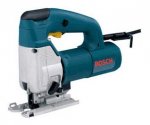Ed Gerhard
Member
- Messages
- 265
- Location
- PA
Larry...
2 cents...
A jigsaw and a sabre saw are the same thing. Mostly called jigsaw these days. Like the Bosch in the photo. Everybody makes a version. Have been around since water. Blade attaches at one end and the other end waves in the breeze...can be a problem with thick stock getting a perpendicular cut. Actually some do have an adjustment to cause the blade to travel in an orbital path inline with the cut for aggressive cutting (Milwaukee for one). The blade is thicker and wider than the blade used on a scroll saw. It can easily be used for an inside cut (handheld of course), as opposed to a bandsaw.
The orange machine is a scroll saw...typically used for more intricate cuts on (usually) thinner material. The blades are much thinner than jigsaw blades and break easily (scrollers buy them by the gross). They attach at both ends. There are many models and two or three different generic designs for having the top arm move up and down. The biggest problem with the cheap ones is vibration...it's difficult to make an intricate cut with a machine that vibrates so much you can't see the cutline. Today's scroll saws go for less than 100 bucks to over two thousand (the one in the photo is around $750).
I disagree that recip saws are replacing jigsaws. The Milwaukee Sawzall (in photo) is the best known reciprocating saw...it's kinda like Xerox has become the generic term for a copy machine, Sawzall has become the generic term for a recip saw. Some jobs are best done with a reciprocating saw, and some jobs are best done with a jigsaw.
Cheers.
2 cents...
A jigsaw and a sabre saw are the same thing. Mostly called jigsaw these days. Like the Bosch in the photo. Everybody makes a version. Have been around since water. Blade attaches at one end and the other end waves in the breeze...can be a problem with thick stock getting a perpendicular cut. Actually some do have an adjustment to cause the blade to travel in an orbital path inline with the cut for aggressive cutting (Milwaukee for one). The blade is thicker and wider than the blade used on a scroll saw. It can easily be used for an inside cut (handheld of course), as opposed to a bandsaw.
The orange machine is a scroll saw...typically used for more intricate cuts on (usually) thinner material. The blades are much thinner than jigsaw blades and break easily (scrollers buy them by the gross). They attach at both ends. There are many models and two or three different generic designs for having the top arm move up and down. The biggest problem with the cheap ones is vibration...it's difficult to make an intricate cut with a machine that vibrates so much you can't see the cutline. Today's scroll saws go for less than 100 bucks to over two thousand (the one in the photo is around $750).
I disagree that recip saws are replacing jigsaws. The Milwaukee Sawzall (in photo) is the best known reciprocating saw...it's kinda like Xerox has become the generic term for a copy machine, Sawzall has become the generic term for a recip saw. Some jobs are best done with a reciprocating saw, and some jobs are best done with a jigsaw.
Cheers.




